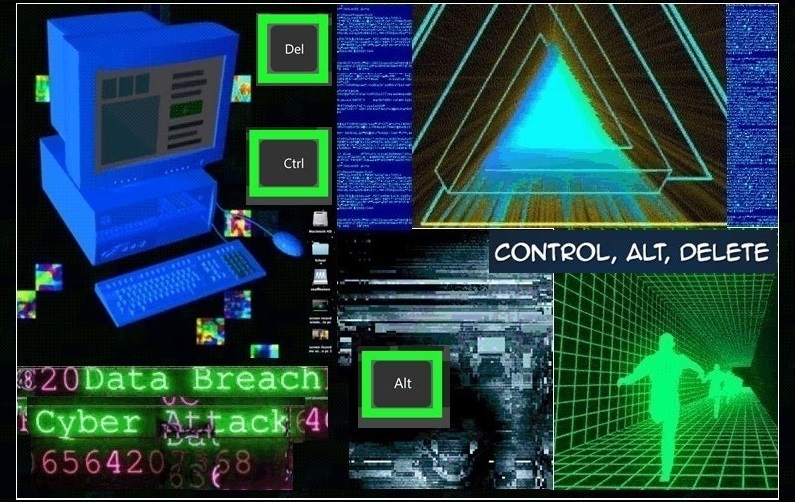
As airlines adjust to electronic luggage tags and travellers exchange paper tickets for boarding passes on smartphones, computer glitches are destined to increase. Cybersecurity experts have a catchphrase – ‘increased dependency on unpredictable issues enable surging failures.’
The term ‘glitch’ or ‘bug’ is the expression that a computer program, system, or machine is defective or faulty. A glitch is a flaw in a system as a result of unknown causes. It can refer to a brief error in a system due to a sporadic hardware fault on an external device or poor power supply that can correct itself, making it difficult to troubleshoot. In Information Technology (IT), a bug is an error or fault in any computer program or hardware system. A software bug is a computer program or system failure in the development, design, or operation of computer software that causes it to yield unexpected results. It can influence the functioning, safety, and security of computer operating systems. Various issues can produce temporary or permanent problems such as programming mistakes, screen abnormalities, keyboard malfunctions, and conflicts with software and hardware installed on a computer.
‘Glitch’ is sometimes substituted with the word ‘bug.’ A computer glitch is when there is a problem with the normal functioning of a computer, allowing it to act strangely. The difference between the two is that a glitch causes a temporary disruption while a bug refers to a serious problem that frequently includes hardware. While interference from portable electronics and microwaves, damaged cables at the broadcasting centre, weather, defects in software and hardware, errors within operating systems, and problems triggered by computer bugs or viruses cause glitches, they can be disruptive on a major organisation’s network. Incorrect interpretation while developing software requirements and human errors while designing programs and writing source codes are some of the reasons why software has bugs.
Removing a virus may be the only way to fix a glitch if it is caused by a computer virus. Once the source is found, it will be easier to fix. A problem hosted by a hardware glitch is known as a technical glitch. If serious glitches are not fixed, they may prompt severe damage such as total system failure. Several software bugs are responsible for space and military aircraft crashes. The famous Y2K bug caused various programs written long before the transition of dates from the 1900’s to 2000’s to malfunction. A massive attempt at the end of the twentieth century fixed the critical problems in the Y2K bug.
An identical problem to the Y2K bug is the Epochalypse or the Y2K38 superbug. It is a time formatting bug that represents times after 03:14:07 (three hours fourteen minutes and seven seconds) Universal Time Co-ordinated (UTC) on 19 January 2038. The problem is dormant in systems measuring Unix time. The number of seconds elapsed since the Unix epoch 00:00:00 (zero) UTC on 1 January 1970. The bug has already challenged several applications that use future dates. Computer systems that use time for critical computations may face fatal errors if the Y2K38 bug is not solved. Although there is no resolution, several modern systems have been upgraded to measure Unix time. Susceptible systems are those that are seldom updated or that have never been updated.
In 2012, the Los Alamos National Laboratory (LANL), a federally funded research and development centre for the National Nuclear Security Administration of the United States Department of Energy, acknowledged that for more than twenty years the commercial aerospace industry, the military, and the computer industry have been aware that high-energy neutrons in the atmosphere are able to effect computer errors. Even Time magazine defined the word ‘glitch’ in a 1965 article as a spaceman’s word for ‘irritating disturbances.’ Time believed that the term was used during the 1950s American Space Race to define minor faults in rocket hardware that could not be described as anything else. In August 2016, the Open Technology Institute, run by the group ‘New America,’ released a report ‘Bugs in the System.’ The report addressed three issues namely: U.S. policymakers should consider amendments to assist researchers in identifying software bugs, adjust the study field to include the discovery of software susceptibility and cyber software vulnerability, and to reform computer crime and copyright laws to ‘the Computer Fraud and Abuse Act, the Digital Millennium Copyright Act, and the Electronic Communications Privacy Act.
Almost ninety percent of emails contain some form of malware. More than six thousand new computer viruses are created every month. A lazy fix twenty-three years ago means the Y2K bug is currently stalking computers. Cash registers and parking meters are victims of a computer glitch related to the Y2K bug. Control Alt Delete is a 2008 Canadian comedy film which premiered at the 2008 Toronto International Film Festival. It is set in an IT firm before the year 2000 where the lead programmer is tasked with solving several Y2K bugs. As the year 2000 approaches, he anxiously works to resolve the Y2K glitch. The bug refers to potential computer errors related to the formatting and storage of calendar data for dates in and after the year 2000. Computer designers forgot to program computer systems to handle four-digit dates. The problem was in the coding of systems across multiple types of software that reduced calendar years in data sets. The panic was that banks, government agencies, and society would shut down after midnight on 31 December 1999. The second after midnight was the entry into the next century. It was expected to create chaos in computers and computer networks around the globe. International programming and preparations started well in advance of twelve months and when the new era finally arrived, few major failures resulted. The millennium bug is the perfect example of how mass hysteria promoted technophobia (the fear of technology).
Computers can do things humans can’t, such as work out complex equations in less time it takes to count to twenty, but software malfunctions can have serious consequences. In the United States, numerous outages at State Department systems have led to various delays in the processing of digital immigration status, passports, and visas as well as applications for passports, visas and reports of Americans born overseas. In June 2015, the U.S. State Department had a failure in the system that conducted security checks on foreign visitors. It ultimately delayed passport-and-visa-processing at worldwide embassies and impacted travel into the U.S. Across United Kingdom airports, border officers have been replaced by e-gates (digital passport gates), allowing travellers with biometric passports to scan their passports and pass through border control. Chaos erupted when an IT system failure stunted the purpose of the UK Border Force’s electronic passport gates at airports across the U.K. The system failure prevented the use of e-gates for arrivals, causing significant delays in processing arriving passengers via manual passport security checks. Australia uses immigration smart gates to process arrivals and departures with only two or three officers on site. An estimated ten thousand passengers arrive per hour across Australia; even a slight delay can have a catastrophic effect. An IT systems outage at all Australian international airports caused a shutdown of electronic gates; thus, all inbound and outbound passengers had to be processed manually by immigration officers. Working with the Department of Home Affairs, the Australian Border Force (ABF) instructed the Department of Border Protection to arrange for extra officers. The complexity of the computer systems powering the global operations of airlines is heavily affected by computer glitches, bugs, and errors. The booking system that American Airlines use to assign pilots to flights indicated that it allocated enough captains and first officers over Christmas when in fact there was a shortage of pilots.
During September 2013, a computer glitch delayed unemployment checks for almost eighty thousand Californians; many depend on the money to feed their families and pay their bills. A computer error at New York’s Housing Authority left residents waiting endlessly for critical paperwork; some even forfeited their homes. The delays were due to a new thirty-six-million-dollar computer system. When a computer glitch in a newly installed computer program in the Dallas County District Clerk’s office limited the retrieval of several court records, defence attorneys could not access vital case information. A California Court installed new legal software known as the Odyssey Case Manager software which led to false criminal records, redundant court trials, and unlawful arrests. Washington state released more than three thousand prisoners early. Nearly three hundred defendants jailed over three days in Harris County were automatically released without appearing in court. A glitch in Everbright’s internal trading systems created chaos on the Chinese stock exchange. The Chinese Securities Regulatory Commission (CSRC) launched a formal inquiry into the unusual trades. In 1991, the collapse of a fifty-seven-thousand-ton sea oil platform caused a massive earthquake. Due to a computer error, residents in Johnson County, Kansas, received a false tornado warning. In 2004, a computer glitch revealed the names of various authors who had written reviews of their own books with the aid of pseudonyms.
Well-known banks that have been seriously affected by either hacking or software and hardware breakdowns – Commonwealth Bank, M and T Bank Corporation, Toronto Dominion Bank (TD Bank), Union Bank, and JPMorgan Chase. Bank of America encountered a problem with several customers unable to access their account information. Wells Fargo (with its headquarters in San Francisco, California) provides banking, investment, and mortgage products. After a systems outage prevented customers from using ATMs, mobile, and online banking services, account issues followed. The glitch happened at a chaotic time for banks in the U.S., amplified by the federal government taking control of Silicon Valley Bank, marking the event the largest American bank failure. Customers reported that direct deposits failed to appear on the system. Wells Fargo mistakenly denied hundreds of customers mortgage adjustments which led to the bank foreclosing on homeowners. The Royal Bank of Scotland computer system problems which started in June 2012 were technical issues that affected computers managed by the Royal Bank of Scotland Group (now NatWest Group), including Ulster Bank, The RBS, and National Westminster Bank. The belief is that the computer failure at the Royal Bank of Scotland was caused by an inexperienced junior technician in India. The computer glitch prevented payments to and from accounts at NatWest, RBS, and Ulster Bank. In 2014, RBS was charged more than forty million British pounds over the incident.
The Federal Aviation Administration (FAA) in Washington, DC. functions as a regulatory agency under the U.S. Department of Transportation with the sole mission of civil aviation safety and air traffic services. It is the largest transportation agency of the U.S. government that regulates all facets of civil aviation in America as well as neighbouring intercontinental waters. The FAA provides the largest, safest, and busiest National Airspace System (NAS) in the world. NAS is a network of controlled and uncontrolled domestic and oceanic airspace. The Notice to Air Missions (NOTAM) sends dynamic information to pilots like alerting them about equipment outages, closed runways, and other potential hazards at a location or along a flight route that could affect the flight. Pilots check the NOTAM system before they commence flight. An FAA ground stop is a process that mandates aircraft that meet explicit criteria to stay on the ground. The conditions for a ground stop may be airspace specific, equipment specific, or airport specific. It is to halt the departure of aircraft destined for an airport or for a geographic area e.g., if a ground stop is called for Los Angeles International Airport, aircraft departing for Los Angeles airport from other airports will be grounded.
During August 2023, the FAA experienced a system outage that affected thousands of flights across the globe. The fault was reported to have been caused by a problem in the NOTAM system. This system failure led to the FAA calling a ground stop which caused ground stops at other airports across America. Major U.S. and U.K. airlines such as American Airlines, British Airlines, Delta Airlines, Southwest Airlines, and United Airlines were mostly affected. On 8 July 2015, computer failures simultaneously took down three major United States companies, United Airlines, the New York Stock Exchange (NYSE), and the Wall Street Journal’s website. The NYSE had a four-hour complete failure; a system error that flowed through to other markets as well. Well-known technologists and security experts all agreed that the outages were not the results of cyberattacks. They explained how each of the three failures were different in nature and how hacks exploit a single flaw to attack several individuals or businesses at once. The New York Stock Exchange is the main exchange in the financial borough of Lower Manhattan in New York City and the Wall Street Journal is an international economic-oriented daily newspaper, also in New York City. The three companies are business operations that rely on complex computer systems with automated software which involves masses of computer coding; a system outage only requires a single mistake!
In 1999, NASA lost its Mars climate orbiter because a NASA subcontractor used English units instead of the metric system, which caused the malfunction of the orbiter’s thrusters. Nasa’s Hubble Space Telescope was replaced with a powerful successor, the James Webb Space Telescope. The Ariane 5 rocket launch delayed scientific research for almost four years. Therac-25 is a machine that delivers radiation therapy to cancer patients. The technicians who worked with the Therac-25 were used to computer glitches; however, a lack of hardware safety features led to a computer bug that delivered radiation overdoses, causing three deaths.















